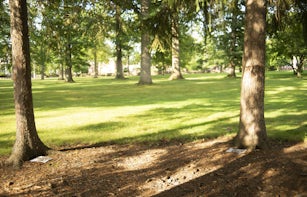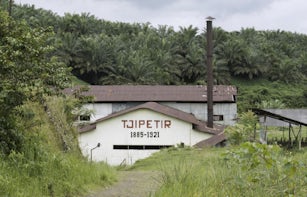Oyster bloody Mary, Christmas pudding and Japanese knotweed ice cream. These might just sound like features of a chic midwinter menu, but in fact, these dishes are punctuations in a growing body of richly researched work by Alon Schwabe and Daniel Fernández Pascual, aka Cooking Sections, who describe themselves as ‘spatial practitioners’. Informed by their backgrounds in architecture and performance, the duo practices the kind of interdisciplinary, idea-led work that stubbornly resists definition, intersecting subjects of food, space, ecology, politics, history and culture.
Cooking Sections’ projects might at first appear somewhat esoteric, with research that takes as its starting point such varied subjects as colonial pudding ingredients, aquaculture practices, pantone shades of salmon flesh and Ukrainian soil health. But the beauty of this work is the way in which it makes clarifying links between seemingly disparate subjects, making history, the contemporary and the future part of the same question. That Cooking Sections use food – that most universal material, imbued with complicated symbolism – as a way to address apparently disconnected spheres is no coincidence. Using cooking and eating as ways to communicate, the duo ensures that viewers (eaters) almost inevitably insert themselves into a broader narrative, seeing with clarity how their experience and choices fit into the systems and dynamics at play around them.
To take a first example, The Empire Remains Christmas Pudding (2013–ongoing), a performance that was part of the broader project The Empire Remains Shop (2013–ongoing), made use of a 1928 Christmas pudding recipe from the Empire Marketing Board, an organisation set up to promote and celebrate the consumption of goods produced within the British Empire. The recipe calls for Australian currants, South African candied peel, eggs from the Irish Free State, nutmeg from the British West Indies and brandy that might be Cypriot or Palestinian. Over time, however, many of these geographical and political boundaries have shifted. Supply chains have become more tortuous, and Britain’s relationship with its own colonial and imperial past has become something to grapple with rather than take solipsistic pride in. Cooking Sections traced these shifting dynamics by recreating that original Christmas pudding recipe. Charting the modern origins of the ingredients used in 1928, and ‘turning the locations in the new recipe for the pudding into an edible map’, they made tangible the changes in Britain’s political, economic and cultural network of supply. 01 Their pudding signals a changing awareness of the former British Empire, and the enduring ghosts of colonial and imperial abuse.
The project Climavore (2015–ongoing), much like The Empire Remains Shop, reflects on serious global issues, however, this project also faces the future, proposing a new form of eating that plays on the idea of the ‘locavore’ (who eats according to what can be locally grown and acquired). Unlike a locavore, the ‘climavore’ would eat according to climate events, their choices not just inflicting less damage on the natural world, but actually improving the ecological health of the land and sea around them. Incorporating detailed research, recipe writing, performance and site-specific installations, this concept is as bold and interesting in its scientific and political outlook as its artistic output. As with The Empire Remains Christmas Pudding, a focus on cooking allows the participant or viewer to consider how their own eating experiences and choices link their bodies and minds to various spatial and temporal contexts.
As the earth and its human and nonhuman inhabitants suffer from the harsh and unpredictable effects of climate change, there are difficulties in rendering the relevant academic research intelligible to a general public audience. One such issue is visibility. For example, while the image of the world’s forests as giant lungs is a familiar one (and one that gathers potency as we witness the combination of rainforest clearances and rampant wildfires that have been ravaging our collective breathing apparatus), less familiar is the idea of the oceans and marine life as vitally important oxygen producing resources. The acidification of oceans is not as troubling a visual as the dramatic burning of plant life and yet it poses a significant risk to our planet.

A recent study has produced evidence that the mass extinction that occurred some sixty-six million years ago was likely to have been caused in part by a sudden, dramatic drop in oceanic PH levels following the meteorite collision that wiped out the dinosaurs. The study takes an in-depth look into the long-distant past, providing new perspectives on our present ecological situation. 02 The authors suggest that we urgently need to address the current acidification of oceans, caused by the absorption of man-made carbon emissions. Dr Michael Henehan, citing the drop of 0.25 PH units that his co-authored report claims has destroyed marine life on a colossal scale, states: ‘ocean acidification can precipitate ecological collapse. […] If 0.25 was enough to precipitate a mass extinction, we should be worried.’ 03
Worrying, however, feels like a painfully passive activity in the context of such evidence. But how can non-specialists begin to consider this kind of research? One issue is that of linking the vastness of academic knowledge with the kind of everyday action, demanding widespread participation, required to make change. The role of artists and designers, as cultural interventionists, is crucial here. By invoking the power of storytelling, prototyping and poetry, artists can convert meaningful words on a page into visual, audible imaginings of better worlds and actions – cultural calls to arms. And by incorporating rigorous ecological research in tangible, sensory, presentations, Pascual and Schwabe’s work allows ideas to be ingested (sometimes physically) and understood. It also responds to the political, social and cultural contexts surrounding that science in new and compelling ways that would be difficult to achieve from within the academy. In the context of food research, the power of this work can be immediate because food is something with which we all engage on a daily basis.04
It is much more widely understood today than it was 50 or even 10 years ago that how we eat impacts on the world around us. But what if questions around how we engage with food could be framed less as damage limitation than in terms of possibilities? What if we could move away from the inconvenient tweaking of diets (being asked to eat less of what we like) and towards positive acts of eating in ways that will improve the health of the planet? With a project like Climavore, Cooking Sections look at what is possible and what could be beautiful, rather than examining perceived behavioural failings. Rather than admonishing, they intrigue, inform and delight. Early iterations of the project saw the development of recipes that utilised drought-resistant ingredients in the context of a temporary water shortage, or seaweed and filtering bivalves in response to polluted shorelines. Not only did Cooking Sections develop a methodology for in-depth research into specific man-made climate and landscape alteration, they also went on to envision entire growing and eating cultures that would respond to these phenomena.




